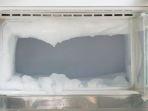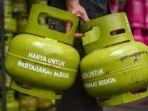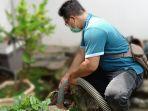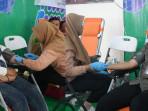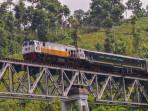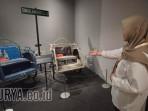East Java Travel Guide
Beach with Cypress Forest in Banyuwangi East Java
This place have clean black sand, beautiful scenery of Bal Strait, and thousands of cypress trees which is grow along the beach
SURYA.co.id | BANYUWANGI - One of the beaches which must be visited in Banyuwangi is Pantai Cemara, with the distance about 5 kilometers from the central city of Banyuwangi.
This place have clean black sand, beautiful scenery of Bal Strait, and thousands of cypress trees which is grow along the beach. The visitors will stay for long time to enjoy the wind from the shady cypress trees.
The thousands of cypress trees do not grow by itself. In 2011, fishermen from Pantai Pakis Rejo has planted 19 thousand of cypress tree seeds along the beach which has 10.2 hectares area and 2 kilometers coastline.
"The seeds that we got are from government assistance, then the fishermen planted them along the beach. Until now, we still continue to plant them in some spot that still barrens," Muhyi explained, the group leader of Usaha Bersama Pantai Rejo.
He said that before plating cypress trees, the beach which was known as Pantai Pakis Rejo was very hot and arid. The fishermen who come home from sea had trouble to take shelter because there was no plants grow. But now, the beach scenery which was dry, arid, and hot have been replaced with the comfortable and shady beach.
Because there are many cypress trees grow, Pantai Pakis Rejo is now known by the name of Pantai Cemara. Muhyi said that the planting of cypress is not without difficulty. In 2015, there is a change in the water flow of the estuary which inflict 1,700s cypress trees uprooted and damaged so the remaining is just 15 thousands of trees.
In 2017, they re-planting about a thousand of cypress tree seeds and then that beach become conservation site of cypress tree. The seeds of cypress tree are no longer from donation, but the fishermen have done the planting by themselves.
"Now there are thousands of cypress seeds which we distributed to several group of fishermen in Banyuwangi who need to be planted in their place. The seeds are the result of scion by the fishermen on the cypress tree in here," Muhyi explained.
Along the time, Pantai Cemara become the one of tourism destinations. the minimum average in everyday is 250 visitors. the numbers will be increased on Sunday or holiday which reach 2,500 visitors every day.
In 2015, the fishermen decided to make special core zone for conservation education of cypress trees about 4 hectares. In this core zone, there are wooden fences and the visitors are forbidden to do any activity except for trekking along the beach trough the sideline of cypress trees which is similar as tunnel.
In the core zone, it is also become the core zone of city forest. whereas for relaxing by rolling out the mats and eating together can be done in the outside of city forest core zone which is utilization zone. do not to worry about being hunger because there are 23 food stalls along the beach which serve many of foods and beverage.
"The core zone we purposely make fence and if want to enter the visitor must pay 2,000 rupiah for education area because sometime there are some undisciplined visitors such as littering or break the branches of trees intentionally. Then now in the core zone, the humus already as thick as 2 centimeters and the soils become very fertile," he explained.
They also made a fish pond in the core zone. So, the visitors not only enjoy the shady of cypress tree but also can see hundreds of tukik or baby turtles in the conservation area which have already been there since 2014.
According to Muhyi, Pantai Cemara often used as turtle nesting places since past ago. then since 2014, the turtle eggs have been moved to breeding grounds and hatched. if not moved, the turtle eggs will be stolen and eaten by predator.
After hatching, the cute baby turtles are took care at the shelter in Pantai Cemara area before being released again to their original habitat.
"2017 till this month we have saved almost 80s olive ridley turtle nest and the average every nest contain 100s more of eggs,” he explained.
Hundreds of tukik which have been took care by fishermen everyday are being fed with shredded fish meat or shells. Muhyi admitted that there are many visitors who interested to come, especially for school children to see the baby turtle.


